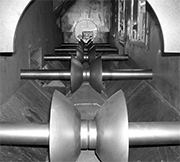E-Archive
Articles
in Vol. 14 - September Issue - Year 2013
In Constant Growth In The Surface Treatment

Particular of a shot-blasting installation for the treatment of heavy materials

Sucker rods after the shot peening treatment

TMV 3-5.5 installation for the sucker rods treatment with automatic loading/unloading system

Trafil stainless to treat metallic bars
The Turbotecnica company has joined the shot-peening process of components used in the oil industry. The collaboration with one of the leading companies in the field has allowed a detailed study for the construction of plants for shot peening able to satisfy the requirements of the customer and ensuring optimal results on the components of oilrigs pumping.
In particular, the treatment is applied to the connecting rods or sucker rods that are the meeting point between the outer surface and the underground. Turbotecnica has designed shot-peening plants with turbines adapted to complete manipulation of rods with size of more than 6 meters in length. The operating cycle provides automated systems of material loading and unloading with related benches to facilitate a further material storage and facilitate operations to the maximum. During the finishing phase, the material undergoes a surface compression process by varying the intensity to eliminate possible break points on the raw material. During this operation, a continuous cold-performed surface hammering process takes place through a constant and decisive jet of spherical pellets of steel with calibration systems integrated in the machine.
The consequence of the process consists of a surface compression with depth included to the tenth of a millimeter, causing a tensile stress in the underlying layer. The balance between the opposing forces of the two layers causes a considerable increase in fatigue resistance, increasing in turn an improvement of the distribution of surface tensions (previously disturbed by mechanical working and / or heat treatments), consequently reducing the stress concentrations caused by slots, threads, decarburization, etc..
Several factors come into play to ensure different effects while maintaining the nature of the material tumbling, such as hardness and size of the pellets, flow rate, speed and angle of impact of the jet, distance of the work piece from the launch of the turbines, the intensity, and coverage. The choice of the pellets depends on different factors such as the quality of the material to peening, the dimensions of the piece, and the final roughness requested. In order to obtain the improvements of hardness and resistance, the shot-peening must be the last finishing operation of the surfaces, while thermal treatments after this process are not allowed since the results begin to disappear with a too-high increase of the temperature reaching 450 °C . In addition to a proper understanding of the treatment methods, it is important to know the final use of the treated material to create a setting that can make the most of the potential effect of shot peening, thus making each installation specific and unique with different characteristics, and constantly evolving.
For Information:
Turbotecnica SpA
via Macchiavelli 19/21
20025 Legnano (MI), Italy
Tel. +39.0331.576744-47, Fax 576745
E-mail: info@turbotecnica.it
www.turbotecnica.it



























